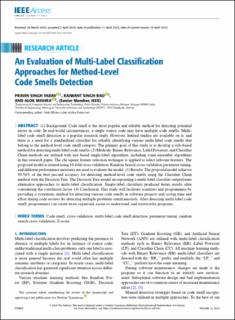| dc.contributor.author | Yadav, Pravin Singh | |
| dc.contributor.author | Rao, Rajwant Singh | |
| dc.contributor.author | Mishra, Alok | |
| dc.date.accessioned | 2024-04-23T11:31:26Z | |
| dc.date.available | 2024-04-23T11:31:26Z | |
| dc.date.created | 2024-04-21T09:21:01Z | |
| dc.date.issued | 2024 | |
| dc.identifier.citation | IEEE Access. 2024, 12 53664-53676. | en_US |
| dc.identifier.issn | 2169-3536 | |
| dc.identifier.uri | https://hdl.handle.net/11250/3127777 | |
| dc.description.abstract | (1) Background: Code smell is the most popular and reliable method for detecting potential errors in code. In real-world circumstances, a single source code may have multiple code smells. Multi-label code smell detection is a popular research study. However, limited studies are available on it, and there is a need for a standardized classifier for reliably identifying various multi-label code smells that belong to the method-level code smell category. The primary goal of this study is to develop a rule-based method for detecting multi-label code smells. (2) Methods: Binary Relevance, Label Powerset, and Classifier Chain methods are utilized with tree based single-label algorithms, including some ensemble algorithms in this research paper. The chi-square feature selection technique is applied to select relevant features. The proposed model is trained using 10-fold cross-validation, Random Search cross-validation parameter tuning, and different performance measures are used to evaluate the model. (3) Results: The proposed model achieves 99.54% of the best jaccard accuracy for detecting method-level code smells using the Classifier Chain method with the Decision Tree. The Decision Tree model incorporating a multi-label classifier outperforms alternative approaches to multi-label classification. Single-label classifiers produced better results after considering the correlation factor. (4) Conclusion: This study will facilitate scientists and programmers by providing a systematic method for detecting various code smells in software projects and saving time and effort during code reviews by detecting multiple problems simultaneously. After detecting multi-label code smell, programmers can create more organized, easier-to-understand, and trustworthy programs. | en_US |
| dc.language.iso | eng | en_US |
| dc.publisher | IEEE | en_US |
| dc.rights | Attribution-NonCommercial-NoDerivatives 4.0 Internasjonal | * |
| dc.rights.uri | http://creativecommons.org/licenses/by-nc-nd/4.0/deed.no | * |
| dc.title | An Evaluation of Multi-Label Classification Approaches for Method-Level Code Smells Detection | en_US |
| dc.title.alternative | An Evaluation of Multi-Label Classification Approaches for Method-Level Code Smells Detection | en_US |
| dc.type | Journal article | en_US |
| dc.type | Peer reviewed | en_US |
| dc.description.version | publishedVersion | en_US |
| dc.source.pagenumber | 53664-53676 | en_US |
| dc.source.volume | 12 | en_US |
| dc.source.journal | IEEE Access | en_US |
| dc.identifier.doi | 10.1109/ACCESS.2024.3387856 | |
| dc.identifier.cristin | 2263199 | |
| cristin.ispublished | true | |
| cristin.fulltext | original | |
| cristin.qualitycode | 1 | |

